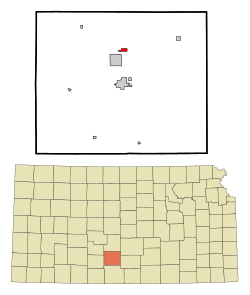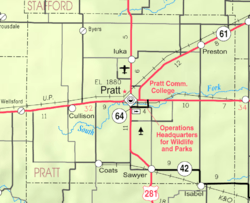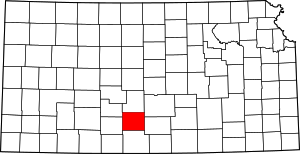Iuka, Kansas
Iuka is a city in Pratt County, Kansas, United States. As of the 2010 census, the city population was 163.[6]
Iuka, Kansas | |
|---|---|
 Location within Pratt County and Kansas | |
 KDOT map of Pratt County (legend) | |
| Coordinates: 37°43′47″N 98°44′5″W | |
| Country | United States |
| State | Kansas |
| County | Pratt |
| Founded | 1877 |
| Incorporated | 1908 |
| Named for | Battle of Iuka |
| Area | |
| • Total | 0.66 sq mi (1.70 km2) |
| • Land | 0.66 sq mi (1.70 km2) |
| • Water | 0.00 sq mi (0.00 km2) |
| Elevation | 1,952 ft (595 m) |
| Population | |
| • Total | 163 |
| • Estimate (2019)[3] | 156 |
| • Density | 237.44/sq mi (91.70/km2) |
| Time zone | UTC-6 (CST) |
| • Summer (DST) | UTC-5 (CDT) |
| ZIP code | 67066 |
| Area code | 620 |
| FIPS code | 20-34625 [4] |
| GNIS ID | 0473934 [5] |
| Website | iukaks.com |
History
Iuka was settled in 1877.[7] It was named in commemoration of the Battle of Iuka in Iuka, Mississippi.[8] Iuka was once the county seat.[7]
The first post office in Iuka was established in December 1877.[9]
Geography
Iuka is located at 37°43′47″N 98°44′5″W (37.729696, -98.734758).[10] According to the United States Census Bureau, the city has a total area of 0.60 square miles (1.55 km2), all of it land.[11]
Demographics
| Historical population | |||
|---|---|---|---|
| Census | Pop. | %± | |
| 1910 | 228 | — | |
| 1920 | 198 | −13.2% | |
| 1930 | 185 | −6.6% | |
| 1940 | 183 | −1.1% | |
| 1950 | 129 | −29.5% | |
| 1960 | 225 | 74.4% | |
| 1970 | 210 | −6.7% | |
| 1980 | 235 | 11.9% | |
| 1990 | 197 | −16.2% | |
| 2000 | 185 | −6.1% | |
| 2010 | 163 | −11.9% | |
| Est. 2019 | 156 | [3] | −4.3% |
| U.S. Decennial Census | |||
2010 census
As of the census[2] of 2010, there were 163 people, 79 households, and 49 families residing in the city. The population density was 271.7 inhabitants per square mile (104.9/km2). There were 83 housing units at an average density of 138.3 per square mile (53.4/km2). The racial makeup of the city was 96.9% White, 1.8% from other races, and 1.2% from two or more races. Hispanic or Latino of any race were 6.7% of the population.
There were 79 households of which 24.1% had children under the age of 18 living with them, 55.7% were married couples living together, 5.1% had a female householder with no husband present, 1.3% had a male householder with no wife present, and 38.0% were non-families. 30.4% of all households were made up of individuals and 12.7% had someone living alone who was 65 years of age or older. The average household size was 2.06 and the average family size was 2.59.
The median age in the city was 48.9 years. 19% of residents were under the age of 18; 5.6% were between the ages of 18 and 24; 21.5% were from 25 to 44; 29.4% were from 45 to 64; and 24.5% were 65 years of age or older. The gender makeup of the city was 49.7% male and 50.3% female.
2000 census
As of the census[4] of 2000, there were 185 people, 78 households, and 60 families residing in the city. The population density was 305.7 people per square mile (117.1/km2). There were 87 housing units at an average density of 143.8 per square mile (55.1/km2). The racial makeup of the city was 98.38% White, 0.54% Native American, and 1.08% from two or more races.
There were 78 households out of which 29.5% had children under the age of 18 living with them, 73.1% were married couples living together, 5.1% had a female householder with no husband present, and 21.8% were non-families. 20.5% of all households were made up of individuals and 9.0% had someone living alone who was 65 years of age or older. The average household size was 2.37 and the average family size was 2.74.
In the city, the population was spread out with 22.2% under the age of 18, 7.0% from 18 to 24, 28.1% from 25 to 44, 25.9% from 45 to 64, and 16.8% who were 65 years of age or older. The median age was 41 years. For every 100 females, there were 92.7 males. For every 100 females age 18 and over, there were 97.3 males.
The median income for a household in the city was $41,250, and the median income for a family was $43,125. Males had a median income of $38,125 versus $19,722 for females. The per capita income for the city was $21,462. None of the population or families were below the poverty line.
References
- "2019 U.S. Gazetteer Files". United States Census Bureau. Retrieved July 24, 2020.
- "U.S. Census website". United States Census Bureau. Retrieved 2012-07-06.
- "Population and Housing Unit Estimates". United States Census Bureau. May 24, 2020. Retrieved May 27, 2020.
- "U.S. Census website". United States Census Bureau. Retrieved 2008-01-31.
- "US Board on Geographic Names". United States Geological Survey. 2007-10-25. Retrieved 2008-01-31.
- "2010 City Population and Housing Occupancy Status". U.S. Census Bureau. Retrieved March 6, 2011.
- Blackmar, Frank Wilson (1912). Kansas: A Cyclopedia of State History, Embracing Events, Institutions, Industries, Counties, Cities, Towns, Prominent Persons, Etc. Standard Publishing Company. pp. 944.
- "Profile for Iuka, Kansas". ePodunk. Retrieved 22 June 2014.
- "Kansas Post Offices, 1828-1961". Kansas Historical Society. Archived from the original on 9 October 2013. Retrieved 22 June 2014.
- "US Gazetteer files: 2010, 2000, and 1990". United States Census Bureau. 2011-02-12. Retrieved 2011-04-23.
- "US Gazetteer files 2010". United States Census Bureau. Archived from the original on 2012-07-02. Retrieved 2012-07-06.
